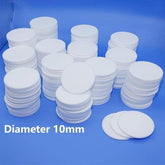What are factors affecting the capacity of quartz capillaries?
Quartz capillaries represent a vital component in chromatographic analysis, owing to their frequent use as a tool for chemical analysis. Its capacity refers to the sample loading capacity of the capillaries, and this directly affects both the separation effect and the detection sensitivity. Therefore, what are the key factors that influence the capacity of quartz capillary tubes?
1. The structural characteristics of quartz capillary tubes
Quartz capillary tubes are manufactured using pure quartz material, which provides high temperature resistance, good chemical stability and high mechanical strength. Its inner diameter is typically measured in the range of tens to hundreds of micrometers, with its length often extending to several centimeters. The smoothness and uniformity of the inner wall of the capillary have a significant impact on its capacity.

2. The definition and measurement of capillary capacity
The capacity of a quartz capillary refers to the amount of sample that the capillary can adsorb and retain under specific conditions. The method of determining the capacity is usually through chromatographic experimentation. This involves measuring the retention time and peak area of the sample in the capillary under fixed conditions.
3. Factors affecting capillary capacity
(1) The inner diameter and length of the capillary
The smaller the inner diameter, the lower the capillary capacity; the longer the capillary, the higher the capillary capacity. This is because the inner diameter and length directly affect the surface area and volume of the capillary.
(2) Properties of the stationary phase
The type, thickness and uniformity of the stationary phase will all affect the capillary capacity. For instance, highly polar stationary phases exhibit a stronger adsorption capacity for polar samples.

(3) Operating conditions
Factors such as temperature, pressure and the composition of the mobile phase will have a significant impact on the capillary capacity. An increase in temperature generally leads to a decrease in the capacity, and alterations in the composition of the mobile phase can also influence the retention of the sample.
(4) Sample properties
The molecular size, shape and polarity of the sample will all affect its adsorption and desorption in the capillary, thereby influencing the capillary capacity.
4. Optimization strategies for capacity
(1) Select the appropriate capillary specification
In order to comply with the nature of the sample and the analysis requirements, a capillary with an appropriate inner diameter and length must be selected.

(2) Optimize the stationary phase
When selecting a stationary phase, the nature of the sample should be taken into consideration, and it is vital to ensure that the phase is evenly coated on the inner wall of the capillary.
(3) Adjust the operating conditions
By adjusting the temperature, pressure and composition of the mobile phase, the retention effect of the sample is optimized and the separation efficiency is improved.
(4) Sample pretreatment
Appropriate pretreatment of the samples, such as concentration and purification, should be carried out to reduce the interfering substances in the samples and improve the analytical sensitivity
5. The significance of capillary capacity in practical applications
The capacity of the quartz capillary is directly related to the sensitivity and repeatability of the analysis. In fields such as food safety testing, environmental monitoring and clinical diagnosis, high-capacity capillaries can increase the lower limit of sample detection and enhance the reliability of analysis. Concurrently, optimizing capacity allows for the reduction of analysis time and enhancement of work efficiency.






